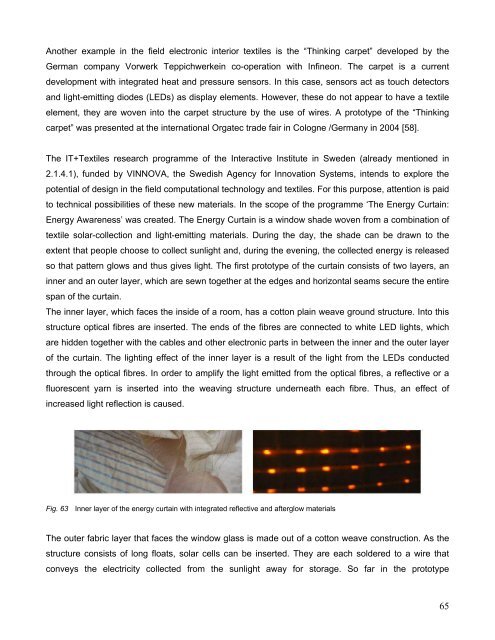Clevertex - Grado Zero Espace Srl
Clevertex - Grado Zero Espace Srl
Clevertex - Grado Zero Espace Srl
You also want an ePaper? Increase the reach of your titles
YUMPU automatically turns print PDFs into web optimized ePapers that Google loves.
Another example in the field electronic interior textiles is the “Thinking carpet” developed by the<br />
German company Vorwerk Teppichwerkein co-operation with Infineon. The carpet is a current<br />
development with integrated heat and pressure sensors. In this case, sensors act as touch detectors<br />
and light-emitting diodes (LEDs) as display elements. However, these do not appear to have a textile<br />
element, they are woven into the carpet structure by the use of wires. A prototype of the “Thinking<br />
carpet” was presented at the international Orgatec trade fair in Cologne /Germany in 2004 [58].<br />
The IT+Textiles research programme of the Interactive Institute in Sweden (already mentioned in<br />
2.1.4.1), funded by VINNOVA, the Swedish Agency for Innovation Systems, intends to explore the<br />
potential of design in the field computational technology and textiles. For this purpose, attention is paid<br />
to technical possibilities of these new materials. In the scope of the programme ‘The Energy Curtain:<br />
Energy Awareness’ was created. The Energy Curtain is a window shade woven from a combination of<br />
textile solar-collection and light-emitting materials. During the day, the shade can be drawn to the<br />
extent that people choose to collect sunlight and, during the evening, the collected energy is released<br />
so that pattern glows and thus gives light. The first prototype of the curtain consists of two layers, an<br />
inner and an outer layer, which are sewn together at the edges and horizontal seams secure the entire<br />
span of the curtain.<br />
The inner layer, which faces the inside of a room, has a cotton plain weave ground structure. Into this<br />
structure optical fibres are inserted. The ends of the fibres are connected to white LED lights, which<br />
are hidden together with the cables and other electronic parts in between the inner and the outer layer<br />
of the curtain. The lighting effect of the inner layer is a result of the light from the LEDs conducted<br />
through the optical fibres. In order to amplify the light emitted from the optical fibres, a reflective or a<br />
fluorescent yarn is inserted into the weaving structure underneath each fibre. Thus, an effect of<br />
increased light reflection is caused.<br />
Fig. 63 Inner layer of the energy curtain with integrated reflective and afterglow materials<br />
The outer fabric layer that faces the window glass is made out of a cotton weave construction. As the<br />
structure consists of long floats, solar cells can be inserted. They are each soldered to a wire that<br />
conveys the electricity collected from the sunlight away for storage. So far in the prototype<br />
65

















